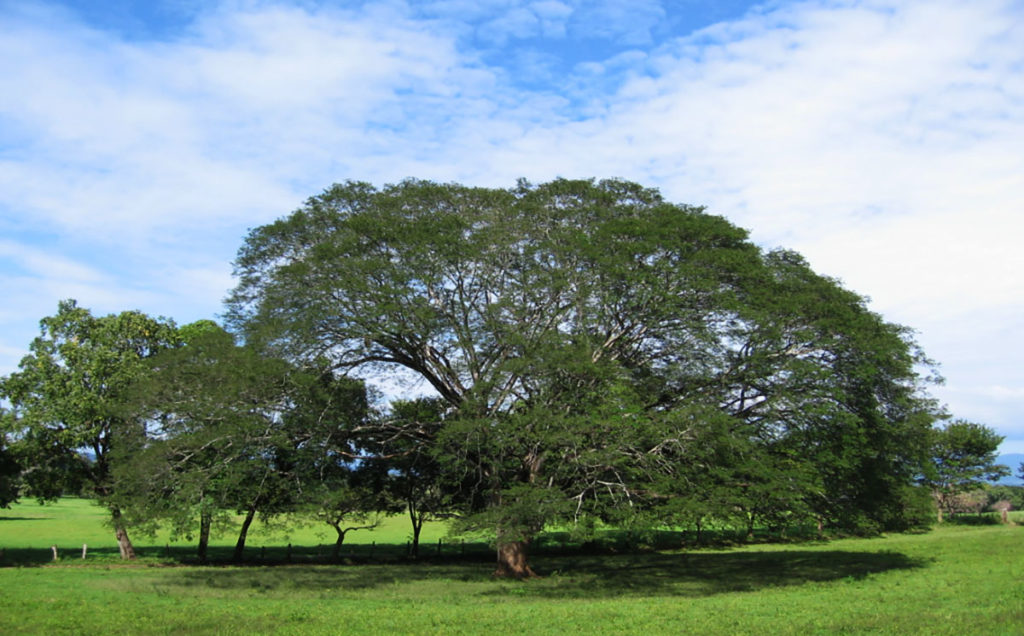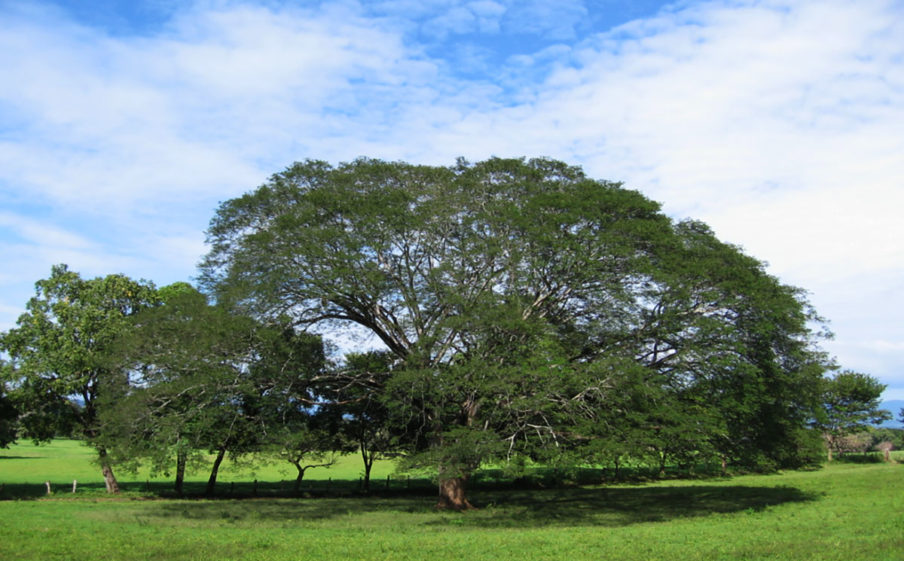
The Guanacaste tree, Costa Rica’s national tree, stands tall across the country’s landscapes, casting shade with its massive, hemispherical canopy. Known scientifically as Enterolobium cyclocarpum, this tree is a cornerstone of Costa Rican culture, ecology, and economy. Its feathery leaves, ear-shaped seed pods, and towering presence make it unmistakable.
From providing food and wood to symbolizing strength and growth, the Guanacaste tree is deeply woven into the fabric of Costa Rica. Let’s explore its characteristics, cultural importance, and practical uses.
What Is the Guanacaste Tree?
The Guanacaste tree, often called the elephant ear tree or monkey ear tree, earns its nicknames from its glossy, brownish seed pods that curl into semi-circular shapes resembling ears. The name “Guanacaste” comes from Nahuatl, the Aztec language, combining “guautil” (tree) and “nacaztli” (ear).
This towering species, part of the legume family (Fabaceae), can grow to 100–160 feet tall with trunks up to 7 feet in diameter. Its canopy often spreads wider than its height, sometimes reaching 165 feet across, like a giant umbrella offering relief from Costa Rica’s intense sun.
The tree thrives in tropical climates with a distinct dry season, commonly found inland along rivers or in open pastures, though it avoids salty coastal areas. It blooms fragrant white flowers from February to April, with fruit ripening from March to April the following year.
The dark brown pods, 7–12 cm in diameter, contain seeds that cattle, parrots, and even humans consume. Despite its abundance, especially in the Guanacaste province named after it, the tree faces threats from overharvesting and is considered endangered in some regions, like among the Mayans, where cutting it is banned.
Cultural Significance in Costa Rica
On August 31, 1959, the Guanacaste tree was named Costa Rica’s national tree, chosen for its beauty and the shade it provides—a symbol of protection akin to the government’s role for its people. Its wide canopy represents the spiritual faith of Costa Ricans, extending beyond the individual, while its strong roots signify the resilience of life. The tree’s rapid growth and seed dispersal reflect themes of renewal and expansion, deeply resonating with the nation’s values.
In daily life, the Guanacaste is a gathering place. Farmers, travelers, and cattle find refuge under its shade, especially in the hot, dry plains of Guanacaste province. Its presence shapes communities, supporting agriculture and livestock, which are central to local economies.
The tree also holds spiritual weight; some legends suggest it connects the living to the afterlife, a bridge between worlds. This blend of practicality and symbolism makes the Guanacaste a beloved emblem of Costa Rican identity.
Ecological Role and Challenges
The Guanacaste tree plays a key role in Costa Rica’s ecosystems. As a nitrogen-fixing species, it enriches soil, benefiting nearby plants like coffee crops, which often grow under its shade. Its canopy shelters wildlife, from howler monkeys to macaws, while its seeds and leaves feed cattle, pigs, and goats. The tree’s deep roots help prevent soil erosion and retain moisture, making it a natural ally against drought.
However, its fast growth raises concerns. In some areas, the Guanacaste is considered invasive due to its aggressive seed germination, with rates near 100%. Seedlings can grow over 3 feet in their first year, outcompeting other plants if not managed. Its strong roots can also damage structures, and falling branches in windy areas pose risks. Despite these challenges, its benefits make it a staple in agroforestry and reforestation projects.
Practical Uses of the Guanacaste Tree
The Guanacaste tree is a multipurpose resource, offering materials and sustenance. Below is a summary of its primary uses:
| Use | Description |
|---|---|
| Wood | Lightweight, water- and termite-resistant hardwood used for furniture, doors, window frames, canoes, and iconic Costa Rican oxcarts. Features swirling red and brown patterns. |
| Food | Green seeds are boiled for human consumption, rich in protein. Roasted or grilled seeds are also eaten. Seeds and leaves feed livestock, especially in dry regions. |
| Medicine | Sap treats colds and lung infections; fruit helps with diarrhea. Sap doubles as a soap substitute for sensitive skin. |
| Crafts | Dried seeds are crafted into jewelry, maracas, and decorative items. Pod pulp, high in saponins, is used as a natural detergent. |
| Shade | Wide canopy shades coffee plantations, livestock, and people, improving soil fertility via nitrogen fixation. |
Wood
The Guanacaste’s reddish-brown wood is lightweight yet durable, resisting water, termites, and fungi. Artisans use it for furniture, doors, and even shipbuilding, valuing its ease of carving and striking grain patterns. It’s a favorite for Costa Rica’s traditional oxcarts, a cultural icon. However, sawdust can irritate eyes and lungs, requiring careful handling.
Food
Green seeds, harvested before they harden, are boiled and eaten as a protein-rich food. In some regions, seeds are roasted or grilled with molasses. Once dried, they become too tough for consumption but are used in jewelry. The seeds and leaves are vital for cattle, especially in dry areas where grass is scarce, making the tree a lifeline for ranchers.
Medicine and Other Uses
The tree’s sap is a traditional remedy for colds and lung issues and can be chewed like gum or used as soap for skin conditions. The fruit aids in treating diarrhea. Additionally, the pod’s saponin-rich pulp serves as a natural detergent, while artisans craft the seeds into necklaces and maracas, adding economic value.
Conservation and Future Outlook
While the Guanacaste tree is abundant in Costa Rica, its popularity for wood and land clearing has raised concerns. Programs like CITES highlight its threatened status in some areas, urging sustainable practices. Costa Rica’s National Tree Day, celebrated on June 15, encourages planting to combat deforestation and climate change. The Guanacaste’s ability to absorb carbon dioxide and retain water makes it a key player in these efforts.
For visitors, spotting a Guanacaste tree is a must. Head to Guanacaste province, near Playa Negra, Tamarindo, or Santa Cruz, to see these giants in their natural habitat. Their shade, beauty, and cultural weight make them a living testament to Costa Rica’s commitment to nature.

